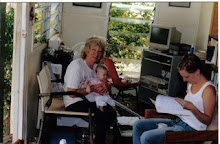Private Mc Veigh.
By Viv. Bibby
When I came to Queensland, Harold said
not to touch the Birds-eye chilies.
Too hot for human use, yet swallowed
whole by lorikeets. “The fiery juice has
blinded some.” He knew from experience.
One Sunday, not too long before he died,
we talked about how many Kiwi soldiers
died, brothers in the Great War, a hundred
thousand from a population of one million.
A little drunk, he told me how for roughly
fifty pounds, a lot in nineteen forty two.
He’d tested poison gas for the Australian Army.
Marching, for hours on end. A dozen others,
with loaded packs, inside a concrete tank,
somewhere, still secret in the Tropic North.
He burned out his lungs and took to drink,
The money was to help Margaret and the boys.
He never marched on Anzac Day, just drank.
A quiet, bitter man, his Anzac story never told.
Tonight I harvest red hot chilies and marvel
at the deadly nightshade starry flowers.
Part of the genus that sustains mankind.
His wife boiled long grain rice each night.
It was the only food Harold could digest.
(story behind this poem is in the accompanying news article.)
Soldiers guinea pigs for chemical weapons in the North. August 15th, 2008
They worked under a shroud of secrecy in some of the most dangerous and unpredictable circumstances of World War II _ many on North Queensland soil.
They were burned and blinded _ two lost their lives _ and some were ridiculed for not serving overseas with the `real' soldiers.
Australia's little-known chemical weapons armourers dealt with the testing, storage and disposal of devastating substances such as phosgene and mustard gas. Some of their stories are detailed in Chemical Warfare in Australia, written by Defence Department employee Geoff Plunkett.
Bombs containing the lethal poisons were stored and disposed of at Talmoi, between Richmond and Julia Creek on the Flinders Highway, where the empty phosgene bomb casings were recycled to use as letterboxes, entrance markers and support stumps for the town's dance hall.
A research station at Bowen was a base for Beaufort bomber crews that sometimes tested the chemicals and equipment by spraying them on to human volunteers and animal test subjects at the Brook Islands, Mourilyan Harbour and Mission Beach.
Accounts in Plunkett's book give graphic descriptions of horrific burns suffered by human `guinea pigs' _ including one from armourer Vic Hicks, who was based at Innisfail.
"On Hinchinbrook Island I saw one of the guinea pigs . . . standing on the beach with his back turned to us," Mr Hicks recalled. "His back was just one mass of huge, long, wide, flat blisters _ it was a horrendous sight that drove home to us just how careful and vigilant we had to be and what we were dealing with.
"An English scientist was standing behind him, legs spread wide with a scalpel and his hand slicing open these huge blisters and the fluid was fast running in a flood down the rest of his body to the ground."
Kevin Garr spoke of being poisoned by phosgene gas _ which would hang in `pockets' near the ground until the wind blew it away _ at Talmoi.
"The pocket entered right next to me and I breathed it in," he told Plunkett. "I'm trying to get my respirator on and my arms are locked and I couldn't get the damn thing on and my lungs are on fire and eventually they noticed me, you know, carrying on, so they grabbed me and put my respirator on for me.
"Our medical orderly, a young bloke, went flying past me in a panic and (Flight Lieutenant) Myers got his Smith and Wesson out and brought him back under gunpoint."
More than 1000 chemical-loaded bombs were dumped in the Coral Sea off Townsville and Cardwell.
Stocks of weapons controlled by the United States were kept at Charters Towers and also at `Kangaroo', west of Toomulla Beach.
It started with WWII and by February 1942, Japan was feared for its stockpile of chemical weapons and its blatant disregard for their international control.
They had refused to sign the Geneva Protocol of 1925, and during attacks on China, had shown they were not afraid to use their lethal arsenal.
With such a merciless enemy close to our shores, the Australian Government established a retaliatory stockpile of its own to deter the Japanese from launching chemical attacks. Mustard gas was used in bombs by the RAAF and in a thickened form which was sprayed from aircraft.
It would burn and blister exposed skin, badly damage the eyes, respiratory and digestive tracts and destroy white blood cells. Phosgene, which caused `dryland drowning' when the nose, throat and lungs swelled and filled with fluid, was dispersed through the air as a fog. It was used in 250lb RAAF bombs and also as a chemical fill for the Army's 4.2-inch mortars and 5-inch rockets. (Townsville Bulletin, 15/08/2008)

1 comment:
Best wishes for your venture in community communication -
Peggy
Post a Comment